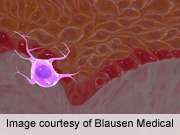New prognostic factors may be useful in predicting survival in patients with thin melanoma, according to research published online July 7 in the Journal of Clinical Oncology.
(HealthDay)—New prognostic factors may be useful in predicting survival in patients with thin melanoma, according to research published online July 7 in the Journal of Clinical Oncology.
Andrea Maurichi, M.D., of the Istituto Nazionale dei Tumori in Milan, and colleagues analyzed data for 2,243 patients with thin melanoma. The authors sought to explore new prognostic factors and construct a nomogram for predicting survival in individual patients.
The researchers found that the worst prognosis for thin melanoma was associated with age older than 60 years, Breslow thickness greater than 0.75 mm, mitotic rate (MR) of 1 or higher, presence of ulceration, presence of lymphovascular invasion (LVI), and regression of 50 percent or greater. All of these factors, except age and regression, were significantly associated with sentinel node positivity. Independent predictors of survival, including age, MR, ulceration, LVI, regression, and sentinel node status, were used to construct a nomogram for predicting overall survival at 12 years.
"Our findings suggest including LVI and regression as new prognostic factors in the melanoma staging system," the authors write. "The nomogram appears useful for risk stratification in clinical management and for recruiting patients to clinical trials."
More information:
Abstract
Full Text (subscription or payment may be required)
Journal information: Journal of Clinical Oncology
Copyright © 2014 HealthDay. All rights reserved.





















